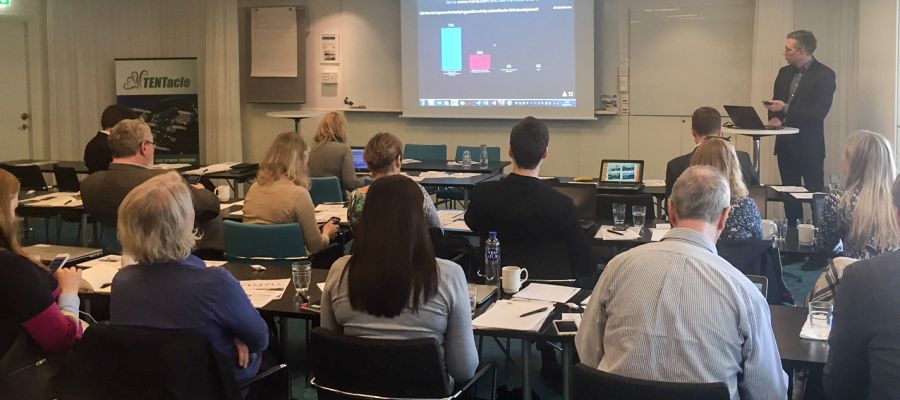
Published 17 Apr, 2018
TENTacle Pilot Showcasing in Stockholm
Stakeholders from national ministries, transport administrations, regions and municipalities, research facilities and market players from the Baltic Sea Region (BSR) came together on the 12th of April for in Stockholm, hosted by the Swedish Transport Administration. The seminar showcased the results from a selection of TENTacle pilot cases.
The seminar was moderated by Björn Hasselgren.
Wiktor Szydarowski, representing the projects’ lead partner Region Blekinge, opened the session by giving a short introduction of the project, followed by an update on the macro-regional activities in TENTacle’s. A connected task led by George Panagakos analysed multilevel governance in the BSR TEN-T corridors and presented the lessons learned in the progress by interviewing involved stakeholders and researching the accumulated experience of past projects and initiatives for corridor management processes.
Lovisa Uhlin at the Örebro Region presented its report on catching the goods transport from the northernmost BSR areas to the Core Network Corridors (CNCs). This report can be used by stakeholders and other interested parties to get a fundamental understanding of the railway market to and from northern Sweden. The report also includes challenges and opportunities for a modal shift in this particular market. An analysis of how to better connect the corridors with the northernmost BSR areas and the transport networks of the EU Eastern Partnership countries by Laima Greiciune, Vilnius Gediminas Technical University, completed this session.
The detailed reports of these three tasks already are or soon will be made available for download on the TENTacle website.
Joakim Ahlberg and Johan Svensson from the consultant agency Ramböll (Sweden) presented interim outcomes of the qualitative impact analysis of the CNCs in the BSR – following an expertise contract drawn with the Swedish Transport Administration. The draft report covers: impacts divided into direct effects - generated by the CNCs as a functional system, and indirect effects - following from the functional system as an enabler of wider economic impacts. Impacts were analysed through the regional context represented by corridor node and transit areas, corridor catchment areas and corridor void areas with the help from two case studies – Fehmarnbelt fixed link and Rail Baltica.
The session on Gdynia as a transport/urban node on the core network corridor, presented by Michał Tuszyński, showcased pilot work for interconnecting the last mile TEN-T corridor infrastructure with that for regional and local transport flows. An urban node atlas with positioned infrastructure investments financed by various donors, a last mile study for complementary investments, auxiliary multi/level governance schemes for the urban node, an integrated information management system and customised urban node statistics are exemplary solutions to be built by the local and regional stakeholders atop the Baltic-Adriatic Corridor (BAC) Work Plan. During the discussion the majority (73%) of the participants agreed that creating good communication channels with regional, national and European authorities would be the best way to improve the position of city authorities to lobby for enhanced CNC development.
Andžejs Stepančuks at the Vidzeme Planning Region shared their positive and negative experiences in developing a regional mobility plan to keep the region physically and functionally connected to the North Sea/Baltic Corridor. Several methods were combined to acquire the necessary data. The methods used include: interviews with authorities and stakeholders, seminars, workshops and roundtable discussions. The seminar stakeholders confirmed that the most effective approach to involve regional businesses in developing such a mobility plan are face-to-face meetings and intense discussions, and that the final output should be implemented through formal agreements with both the national and the local authorities.
The next session, presented by Leif Lendrup, dealt with the problem of how to reverse depopulation and economic stagnation trends in the central Scandinavian borderland, namely in the area of Värmland and Østfold, and the missing high capacity transport link between two national capitals on the Scandinavian-Mediterranean corridor, Oslo and Stockholm. Contemporary conditions and research from the fields of globalization, urbanization, migration, sustainability, technology, society and economy were taking into account when formulating recommendations to improve the overall situation of the region.
The construction of a high speed railway between Oslo and Stockholm and the implementation of supporting regional development and growth directed strategies in Värmland and Östfold were identified as the two most promising solutions.
The audience perceived funding availability as the most critical factor, apart from the political leadership, to achieve the Oslo/Stockholm high speed railway. Commitment of local entrepreneurs was found the most important local measure to keep up with the infrastructure developments.
The Päijät-Häme – North Karelia Pilot Case, presented by Matti Utriainen, discussed their interim results on how to improve the accessibility of corridor void areas. Two idea labs took place in Joensuu and Lahti to interact directly with the local stakeholders. The idea labs were used to find solutions for better road/rail/air interoperability and infrastructural connections, embedding technological innovations in transport and logistics chains to reduce carbon footprint, cut transport costs and attract new businesses. During these meetings the intermodal terminal at Kouvola and the Joensuu airport were identified as the most promising hubs in the region. The audience was asked which action would help the logistics industry the most in lowering emissions. Initially, using alternative fuels was favoured by 71%, but during the discussion the participants came to the conclusion that a combination of factors and actions would probably be the most effective. Examples for such factors and actions are: convincing lobbying and networking, influence of legislation and taxation and incorporating energy efficient vehicles in the logistic chain.
Maria Öberg concluded with an outlook on the future stakeholder interfacing process of TENTacle: The series of stakeholder events will be finished in autumn 2018 by discussing similarities, differences and effects of geographical distance to the CNCs in project results across the pilot cases. The final conference will be organised in spring 2019 together with TENTacle’s sister projects NSB CoRe and Scandria2Act.
More information:
Wiktor Szydarowski
Region Blekinge
wiktor.szydarowski@regionblekinge.se
Inga Gurries
Port of Hamburg Marketing
gurries@hafen-hamburg.de